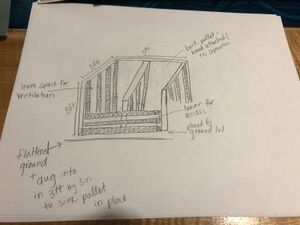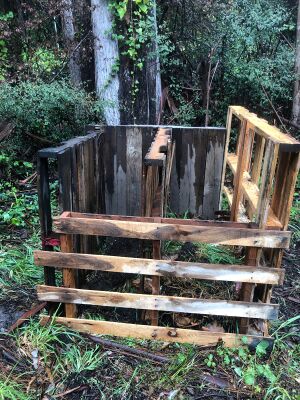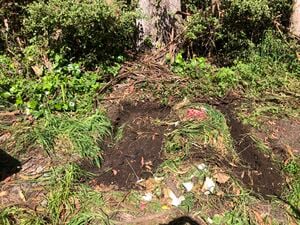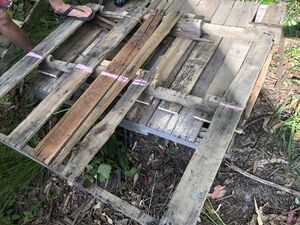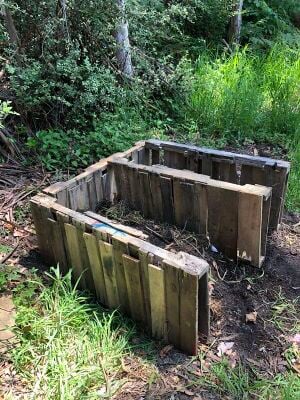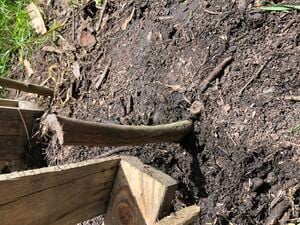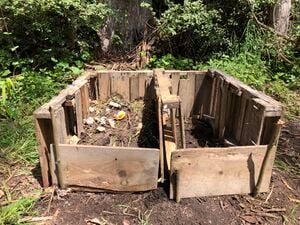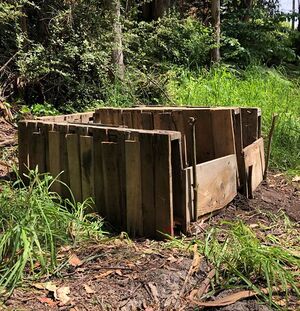
This compost was to tend to the waste of a 4 person household in Arcata, California. The house had a garden beginning and produced a fair amount of green-waste. My goal was to have a flowing system that would produce finished compost over time but one that needed little turning. I also needed something I could deconstruct easily if I left the house. It was in budget and desire to take useable material out of the waste stream. therefore I choose pallets for the main material. I made the system quick as the COVID-19 pandemic set in, without altering the pallets much. After this, I was able to test the design and see what types of needs the house had and how accessing the bays went. Redesigning it gave a whole new design fitting the house's needs and size very well! This is a project anyone can do with a little tool borrowing.
Criteria[edit | edit source]
| Criteria | Constraints | Weight (1-10) |
|---|---|---|
| Accessablity | Compost should be user friendly to all those in the household as well as future tenets. The system should be reachable for dumping as well as turning. | 9 |
| Functionality | Able to take in compost from 4 plant-based eaters as well as garden and lawn waste. Stands up to heavy rain. Keeps food scraps inside. | 10 |
| Uses Waste | Use materials going into the waste stream to use of them. Minimizes cost. | 10 |
| Move-ablitiy | This system is not needed to last a long time but rather should be able to be deconstructed quickly in case of moving out or landlord changing. | 8 |
Construction[edit | edit source]
Here is how I revamped the oversized pallet system to fit the needs of my household.
How to Build[edit | edit source]
Start with a simple design in mind. Map out the space and what materials you have. You will want to choose a plot that is both accessible to you in a moment between dinner, yet out of the way of things like any important plants. It is nice to have your compost receive sun and water. Preferably not under evergreen trees, for do not easily decompose.
After deconstructing the pallets, prepare the space by measuring a layout (3' by 3'). Then, clear the space using a metal rake. Finally, using a hoe, scrap 2 inches into the ground to sit pallets into the ground. This area was already quite soft due to the compost being there before.
This post can be made with sturdy hardwood sticks, the sides of pallets, or a metal pole. Dig the stick into the ground and fill in with soil around it. It should be very snug in the ground. You may want to use a hammer to tamp it down (not for metal pole).
Conclusion[edit | edit source]
Video Demonstration[edit | edit source]
Here is a short video showing and explaining the compost system before and after:
Short video on how to navigate the system.
Troubleshooting[edit | edit source]
From the first design to the second, these were some adjustments I made. I also made a flow chat to help figure out what is wrong with your compost and how to fix it.
| Problem | Suggestion |
|---|---|
| Compost not decomposing | to small of compost for space |
| Cannot reach back of bays | shorten system |
| Food falling from sides | close holes in pannels |
Lessons learned[edit | edit source]
Building a compost system on a larger scale is very obtainable. Even this rustic one has a nice aesthetic and functions well. Getting to learn from what the inside is doing is the real challenge. Overall, this compost operated as both a windrow pile that could simply sit and decompose over less than a season's time. Or it can be turned to speed up the process. Harvesting finished compost felt great! And the plants enjoyed it!
